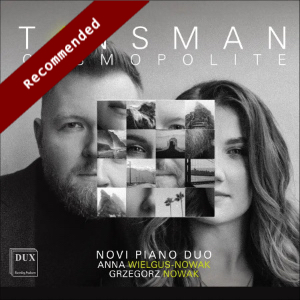
Alexandre Tansman (1897-1986)
Cosmopolite
Le train de nuit (Fantaisie pour deux pianos) (1951)
La grande ville (Ballet en trois tableaux) (1935)
Fantaisie sur les valses de Johann Strauss (1961)
Trois fugues (1942)
Introduction et fugue (1938)
Novi Piano Duo
rec. 2023, Kielce, Poland
Dux 1969 [54]
The word “Cosmopolite”, or citizen of the world, suits Alexandre Tansman well. He was born in Poland, and spent much of the 1920s and 1930s in Paris, where he was a friend of everyone who was anyone. He emigrated to the USA in 1934, and returned to Europe in 1946. His music was commissioned and performed by the leading soloists, conductors and orchestras.
With the rise of post-1945 modernism, Tansman’s music appears to have faded from the repertoire. (I have never seen a live performance of his music in the UK, nor heard any on BBC Radio.) With the advent of the CD, his music has been rediscovered and well recorded. This is all to the good. He must have clearly been a very gifted musician, facile, versatile and skilled in small- and large-scale forms. His works will seem familiar to anyone interested in the music of Les Six and their followers.
Tansman wrote Le train de nuit as a comedy ballet for choreographer Kurt Jooss. In the story, a Mr Boldy falls asleep in the train while returning from the opera. The railway compartment dissolves from time to time as reality and illusion come into contact. The travellers find themselves dancing with the operatic nymphs and fauns that haunt Mr Boldy’s imagination. The ballet garnered excellent reviews when shown at Sadler’s Wells. It was described as a “frolicsome addition” to Jooss’s otherwise thorny repertoire. The driving rhythm of a fast-moving train is brilliantly portrayed before the protagonist drifts off to sleep and his dreams appear. There are jazzy waltzes, fragments of ragtime and things that go bump in the night. It is brilliantly done, and no scene outstays its welcome. It works very well even if one does not know the scenario, not included in the booklet anyway.
La grande ville, another ballet score written for Jooss, has been staged many times over the years, usually under its English title The Big City. It is Jooss’s best known work after the enormously popular The Green Table. The ballet premiered in Cologne in 1932 in an incomplete version set to Tansman’s Sonatine transatlantique. Three years later, he supplied a completely new longer score. He wrote the new music to fit the existing portion of the ballet, always a composer’s nightmare, and it was no mean feat. Jooss then completed the choreography. The Sonatine transatlantiqueincluded popular dance forms – foxtrot, blues and charleston – and Tansman followed this through in the new score.
The story itself is simple candyfloss familiar from musicals of the time. A young worker is happy with his girl. A rich playboy seduces her, and the young man is left alone in the frenzied loneliness of cities. Everything about the music is redolent of the nineteen‐thirties. In the work, Tansman and indeed Joos captured a microcosm of the period. The popular forms from the Sonatine transatlantique reappear here. The bluesy second-movement Cités ouvrière seems very glamorous for what translates as workers’ housing estate!
Why the Fantaisie sur les valses de Johann Strauss is not in the repertoire of every piano duo, I do not know. It is a gloriously glamorous arrangement of Strauss’s popular melodies. They all rub shoulders in unexpected conjunctions surrounded by sparkling filigree accompaniments. This is easy to listen to, but it obviously needs virtuoso pianists, and these two performers certainly are.
The solid and dramatic fugues that round off the programme show Tansman’s side very different from the preceding flashy dancing music. Think the sound world of Busoni’s Bach arrangements, and you will feel comfortable. They sound beautifully written but, after what has gone before, they feel like heavy port after sparkling champagne.
Anna Wielgus-Nowak and Grzegorz Nowak are a superb piano duo. Their coordination is absolutely precise, yet they keep a sense of life so needed in the dance-inspired works. That is even more so in the chordal harmonies of the fugues which they play as one unit, no easy task. No detail is lost in the quicksilver contrapuntal passages of the other works. If that is not enough, they have a great feeling for the syncopated rhythms of the jazz age which infuses most of this music.
Paul RW Jackson
Buying this recording via a link below generates revenue for MWI, which helps the site remain free



















